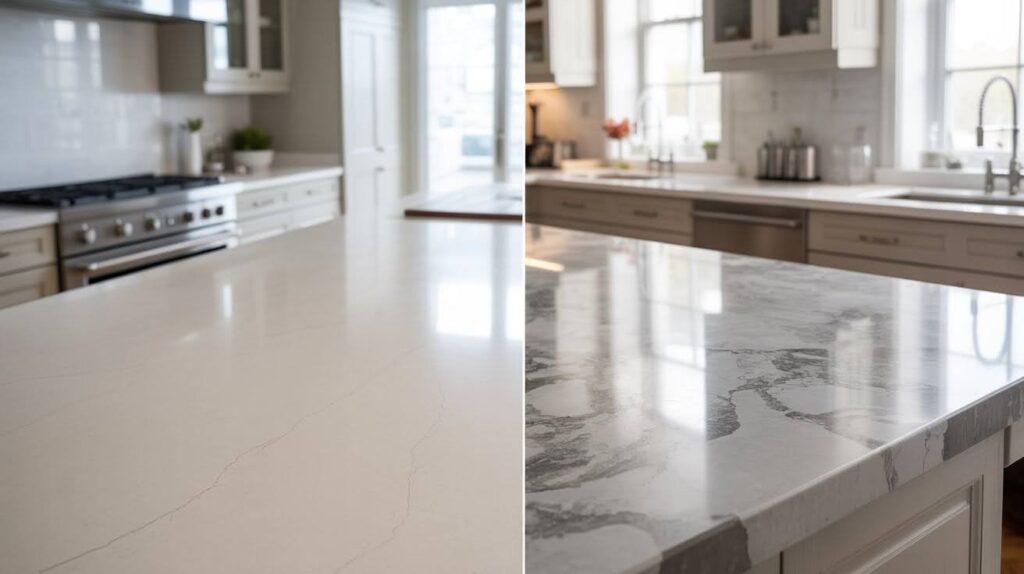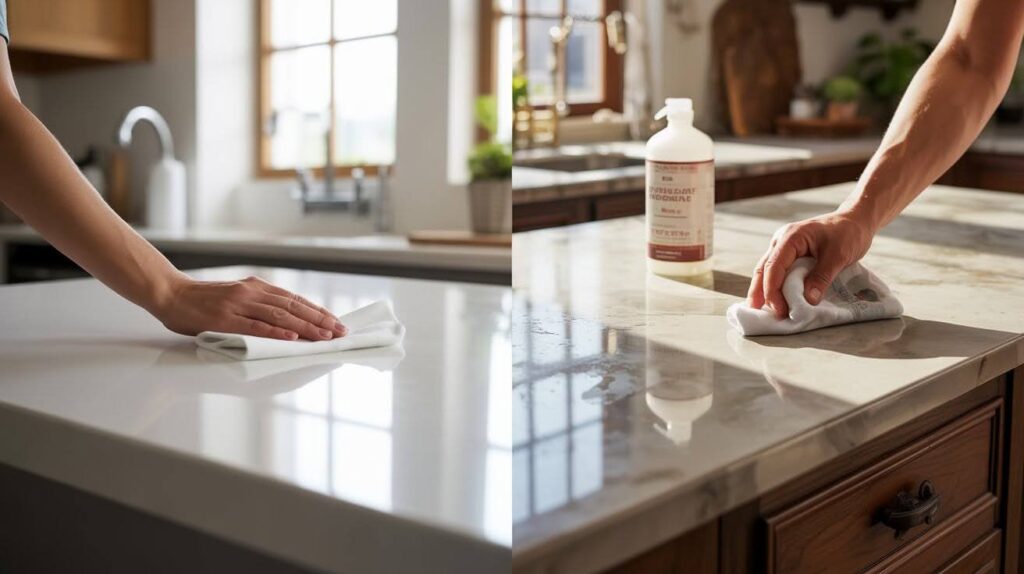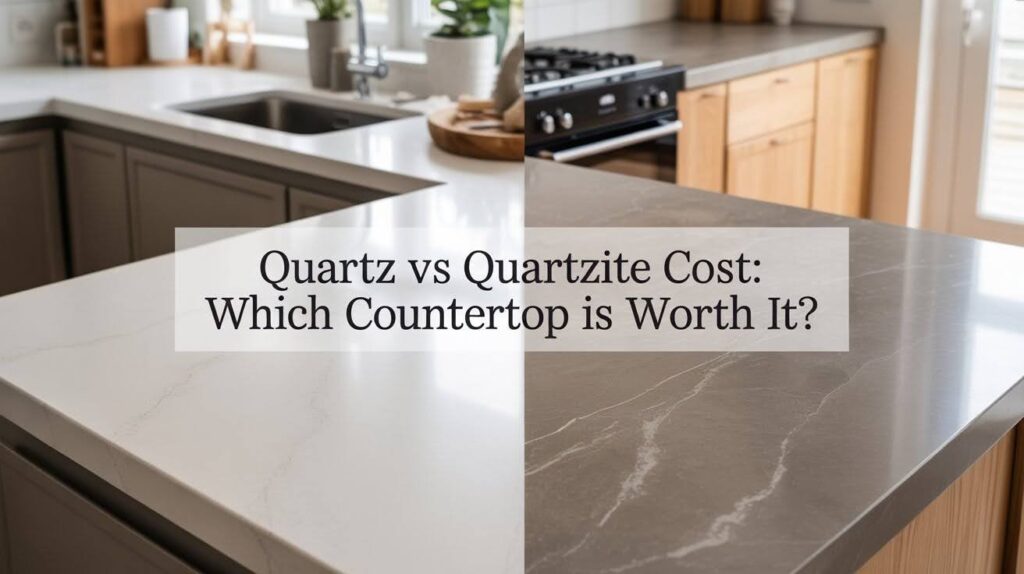Choosing between quartz and quartzite for your kitchen counters?
You’re not alone. These two materials look remarkably alike, but their prices tell different stories. One might cost you significantly more upfront, while the other could require expensive care down the road.
So which one actually saves you money in the long run?
In this guide, we’ll break down the real costs of both options. You’ll see what affects their prices, what maintenance they need, and which delivers better value for your home.
Let’s help you make a choice you’ll feel good about for years to come.
Understanding the Basics: Quartz vs Quartzite

Before comparing costs, let’s clarify what these materials actually are. Knowing the difference helps you understand why prices vary.
What Is Quartz?
Quartz countertops are made in factories. Manufacturers combine crushed natural quartz with resins and pigments.
This creates consistent colors and patterns. No surprise variations across your counter.
Quartz is durable and resists stains and scratches. It needs minimal care with no sealing required. Just soap and water for cleaning.
Perfect for busy kitchens where practical matters most.
What Is Quartzite?
Quartzite is natural stone. It forms when sandstone undergoes intense heat and pressure underground over millions of years.
Each slab is completely unique with natural veining and color patterns.
This stone is extremely strong and lasts a lifetime with proper care.
If you want authentic, one-of-a-kind beauty, quartzite delivers that natural look.
Quartz vs Quartzite Cost Comparison

Let’s talk numbers. Understanding the price differences helps you budget properly and avoid surprises when you get your final quote.
Average Cost per Square Foot Installed
Here’s what you can expect to pay for a typical kitchen countertop:
| Material | Average Cost (Installed) | Price Range for 30-40 sq. ft. |
| Quartz | $50 – $200 per sq. ft. | $1,500 – $8,000 |
| Quartzite | $65 – $150 per sq. ft. | $2,000 – $6,000 |
Why does quartzite usually cost more upfront? It’s all about the process.
Quartzite must be extracted from quarries, often in remote locations. Then it travels long distances to reach fabricators. Cutting and shaping natural stone requires specialized tools and expertise.
Quartz prices stay more predictable. Factories control production from start to finish. This consistency means fewer price surprises.
Factors That Influence Cost
Several things affect your final bill beyond the base material price:
- Material Quality and Brand: Premium brands like Cambria, Caesarstone, and Silestone charge more for quality guarantees. Generic options cost less but offer fewer color choices.
- Slab Thickness and Edge Design: Standard slabs are 2cm or 3cm thick. Thicker slabs cost more. Custom edge profiles add character but increase your bill.
- Color and Pattern: Basic quartz colors are more affordable. Exotic patterns cost more. For quartzite, rare colors and dramatic veining drive up prices.
- Location and Labor Costs: Urban areas charge more for installation. Rural areas have lower labor rates but fewer fabricator options.
- Old Countertop Removal: Removing existing countertops adds $200 to $500. This includes disposal fees and prep work.
Maintenance and Long-Term Value

The sticker price is just the beginning. What you spend over the years matters just as much as your initial investment.
Quartz Maintenance Costs
Quartz makes life easy. The material is non-porous, which means liquids can’t seep in. You’ll never need to seal it.
Cleaning takes minutes. Soap and water handle most messes. For tougher stains, a gentle cleaner does the trick.
Your ongoing costs? Practically zero. No special products required and no professional maintenance needed.
Quartzite Maintenance Costs
Quartzite needs more attention. Being natural stone, it’s porous and can absorb liquids if left unprotected.
You’ll need to reseal it one to two times per year. Professional sealing costs $100 to $300 per application. DIY sealing runs $50 to $100 for materials.
Over ten years, this adds $1,000 to $6,000 to your total investment. Factor this into your budget when comparing options.
Which Offers Better Long-Term Value?
The answer depends on what matters most to you.
- Quartz wins on convenience: Lower maintenance costs mean more money in your pocket over time. Busy families appreciate hassle-free care.
- Quartzite wins on aesthetics and resale appeal: That natural stone beauty catches buyers’ eyes. Homes with high-end natural stone often command better prices. The durability means it can last decades without replacement.
Think about your priorities. Need low maintenance? Go with quartz. Want that authentic stone look that impresses? Quartzite might be worth the extra care.
Quick Summary: Quartz vs Quartzite Cost Table
| Feature | Quartz | Quartzite |
| Cost (Installed) | $50-$200/sq. ft. | $65-$150/sq. ft. |
| Maintenance | Low, no sealing | Needs sealing |
| Durability | High | Very high |
| Heat Resistance | Up to 300°F | Up to 1,000°F |
| Appearance | Uniform, modern | Natural, unique |
| Long-Term Value | Great for low upkeep | Great for premium resale |
Durability and Heat Resistance Comparison

How well do these materials hold up in real kitchens? Let’s compare their strength and heat tolerance.
Scratch and Heat Resistance
Quartzite takes the heat.
This natural stone rates 7 to 8 on the Mohs hardness scale. That’s harder than most kitchen knives.
It handles temperatures up to 1,000°F. Hot pans can go directly on the surface without damage.
Quartz has limits.
Quartz is durable but sensitive to heat. Temperatures above 300°F can cause discoloration or warping.
Always use trivets or hot pads. The resin doesn’t handle extreme heat well.
Everyday Use and Longevity
Both materials resist chips and cracks during normal use. Dropping heavy items can damage either surface, so use cutting boards.
Who should choose what?
Quartzite fits heavy-use kitchens with lots of cooking. Its heat resistance is ideal for frequent bakers.
Quartz suits low-maintenance households. It handles everyday tasks without special care.
Both last 20+ years with proper use. Choose based on your cooking habits, not durability worries.
Visual Appeal and Design Flexibility

Your countertops set the tone for your kitchen. Let’s see how these materials look and what design options you have.
Quartz Appearance
Quartz offers control and consistency.
You’ll find a wide color range from pure whites to deep blacks. Even bold colors like blue or green are available.
Patterns stay uniform across the entire slab. No surprises during installation.
The look is clean and modern. Perfect for contemporary kitchens.
Want custom colors or consistent finishes? Quartz delivers both.
Quartzite Appearance
Quartzite brings natural beauty to your space.
Each slab features unique veining and color variations. Many look like high-end marble with better strength.
No two slabs match. Your countertop becomes a one-of-a-kind feature.
The organic texture adds depth and character that changes as light shifts throughout the day.
If you love natural materials and want something unique, quartzite is your answer.
Which Is More Cost-Effective?
The cheaper option isn’t always the better deal. Quartz works well for homeowners wanting quality without ongoing costs.
You’ll save hundreds on maintenance over the years since it needs no sealing. Quartzite costs more upfront and requires annual care, but that natural stone beauty can boost your home’s resale value.
When budgeting, include all costs: materials, installation, old countertop removal, and yearly maintenance.
Add up expenses over 10 to 15 years for the true cost of ownership. The most cost-effective choice depends on your lifestyle, budget, and kitchen priorities.
Final Thoughts
You’ve got the facts now. Quartz gives you lower upfront costs and minimal maintenance. Quartzite offers that premium natural finish but comes with a higher price tag and regular sealing needs.
Neither choice is wrong. It’s about what fits your life and budget.
Before you decide, get quotes from local installers. Prices vary by region, and you deserve accurate numbers for your specific project.
Ready to move forward? Compare quartz vs quartzite costs in your area to find the perfect balance of style, budget, and durability for your kitchen.
Frequently Asked Questions
Is quartz cheaper than quartzite?
Quartz typically costs less upfront, ranging from $50 to $200 per square foot installed. Quartzite runs $65 to $150 per square foot, though both can overlap depending on quality and brand.
Does quartzite stain easily?
Quartzite can stain if not properly sealed since it’s a porous natural stone. Seal it once or twice yearly to protect against spills and keep it looking fresh.
Can you put hot pans on quartz countertops?
No, avoid placing hot pans directly on quartz surfaces. Temperatures above 300°F can cause discoloration or damage to the resin, so always use trivets or hot pads.
How long do quartz and quartzite countertops last?
Both materials can last 20 years or more with proper care. Quartz needs minimal maintenance while quartzite requires regular sealing, but both offer excellent longevity.
Which countertop is better for resale value?
Quartzite often appeals more to luxury home buyers due to its natural stone status. However, quartz is also highly desirable for its durability and low maintenance, making both solid choices for resale.

